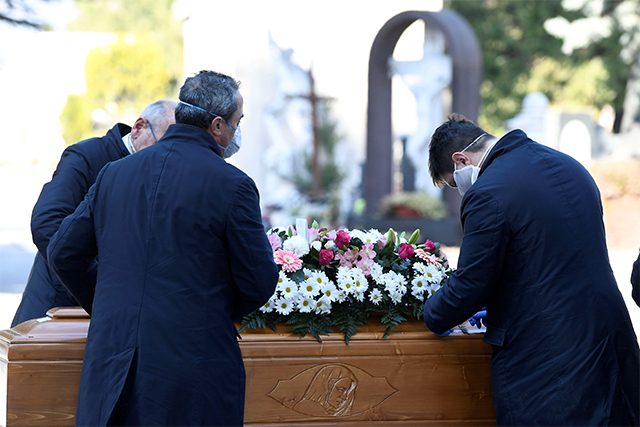
The coronavirus is not only affecting the way we live, it’s also dramatically affecting the way we die.
In Australia, Prime Minister Scott Morrison announced that funerals would be limited to a maximum of ten people to limit the spread of COVID-19. However, the states may have some leeway in permitting an extra one or two.
Funeral directors say they are concerned about the availability of crucial health supplies such as masks, hand sanitiser and body bags.
In Italy, people with COVID-19 reportedly “face death alone”, with palliative care services stretched to the limit, morgues inundated, funeral services suspended, and many dead unburied and uncremated.
In Iran, satellite photography shows trenches being excavated for mass burials.
Read more:
The case for Endgame C: stop almost everything, restart when coronavirus is gone
As Australia’s coronavirus response moves into a critical period, these examples remind us that how we care for the dead must be part of our pandemic plan.
It is extremely difficult to estimate the total number of people who will die in Australia from COVID-19. Predictions range from 3,000 to 400,000.
Our morgues, crematoria, cemeteries and funeral homes will certainly be stretched to capacity.
Family and loved ones may be facing a very different funeral to the one they envisaged.
And while funeral directors and others in the deathcare industry are changing the way they care for the dead, there are clearly challenges ahead.
Can I kiss my loved one goodbye?
Traditions that include kissing, hugging, and dressing the dead have often been abandoned or significantly modified during pandemics.
For instance, during the Ebola outbreak of 2013-16, governments were forced to separate the dying and dead from their communities, enforce new non-contact methods of burial, and in so doing, transform how people mourned.
In Australia, the latest federal guidelines (updated March 25) advise families not to kiss the deceased. However, they can touch the body if they wash their hands immediately afterwards or use alcohol-based hand sanitiser. In most cases, family members do not need to use gloves.
How are funerals changing?
Travel bans and mandatory self-isolation periods can delay some funerals.
And funerals that pull people from distant places into intimate proximity, often including vulnerable people, present a clear health risk.
For instance, in Spain, more than 60 cases of COVID-19 were traced back to one funeral service.
While Australia has limited the size of funerals, other countries have temporarily banned people from attending them altogether.
Read more:
Why are older people more at risk of coronavirus?
Deb Ganderton, chief executive of Melbourne’s Greater Metropolitan Cemeteries Trust, told us:
Everyone has the right to expect a funeral and burial service that respects their individual beliefs. For the families, friends and loved ones of the deceased, an end of life service can also be an important part of the grieving process and help them cope with their loss.
So we need to be creative to find ways to both protect that right and protect public health.
More funerals and memorials going online
In many countries, including the US, UK and Australia, as funeral services are being scaled back or suspended to limit spread of the coronavirus, online services are flourishing.
Our DeathTech Research Team has been following this move to streamed funeral and memorial services. We’ve also been following interest in using hired robots, which people control from afar, to allow people to attend a funeral who can’t be there in person. We predict more innovative use of technology in coming months.
We may also see more people using digital technology such as social media sites for sharing personal memories of the dead and expressing emotions, particularly if they can’t attend funerals in person.
What’s happening behind the scenes?
The coronavirus is also challenging the deathcare industry – which includes funeral homes, cemeteries, morgues and crematoria – for a number of reasons.
International guidelines for funeral directors say that after death, the human body does not generally create a serious health hazard for COVID-19. NSW guidelines say funeral directors and people working in mortuaries are unlikely to contract COVID-19 from deceased people infected with the virus.
However, both sets of guidelines do set out detailed infection control procedures.
Adrian Barrett, senior vice-president of the Australian Funeral Directors Association, told us:
There’s a lot of inconsistency in advice about death and funerals between different states and federal government […] Recommendations around coronavirus can be in conflict. We’d rather have and follow conservative guidelines, to make sure we are doing as much as possible.
Then, there’s the issue of staffing. Although many other sectors can find ways to isolate or temporarily close, cemetery, funeral, and crematoria workers provide an essential service and cannot work from home.
We rarely think about the welfare of those who handle the dead. These workers are too often stereotyped as profiteering in the face of grief, or stigmatised by the taboos surrounding their work. But there is a deep sense of service and care that pervades this professional community.
Read more:
Friday essay: images of mourning and the power of acknowledging grief
For this community, safe working conditions means ensuring the supply of personal protective equipment. However, Adrian of the Australian Funeral Directors Association told us funeral homes across Australia are struggling to source items such as masks and have run into problems with suppliers profiteering by raising prices.
Finally, we need to advertise broadly a public duty of care for those in the deathcare sector. These are the people who safely dispose of bodies and care for people dealing with the loss of loved ones.
Coronavirus has, in such a short time, radically transformed how we live our daily lives as well as urgently reminded us about the fragility of life.![]()
Tamara Kohn, Professor of Anthropology, University of Melbourne and Hannah Gould, ARC Research Fellow, University of Melbourne/ This article is republished from The Conversation under a Creative Commons license. Read the original article.









